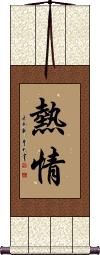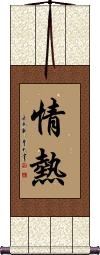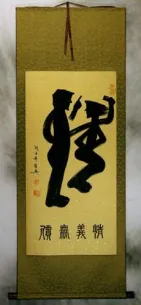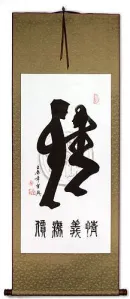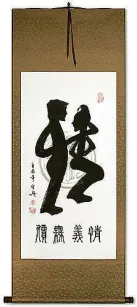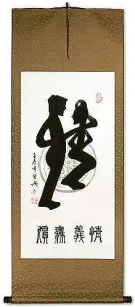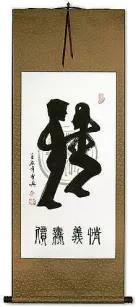Many custom options...
And formats...

Passion for a Cause in Chinese / Japanese...
Buy a Passion for a Cause calligraphy wall scroll here!
Personalize your custom “Passion for a Cause” project by clicking the button next to your favorite “Passion for a Cause” title below...
Passion for a Cause
Depending on the context, 熱情 can mean “cordial,” “enthusiastic,” “passionate,” or “passionately.”
This version is sometimes used in Japanese, but the character order is more common in Chinese and Korean Hanja. The meaning in Japanese for this Kanji order is ardor/ardour or zeal but rarely used in modern Japan. I suggest you choose a different version of “passion” if your audience is Japanese.
See Also: Persistence | Devotion | Tenacity | Commitment | Motivation
Enthusiasm / Passion for a Cause
情熱 is the Japanese word that means enthusiasm or “passion for a cause.”
In some contexts, this could mean being extremely fond of something or having a fondness for a cause or person.
Can also be translated as passion, zeal, ardor/ardour, or fervor.
Note: This word (or character order) is not natural in Chinese. However, a typical Chinese person can guess this is a Japanese or Korean word and understand the intended meaning. This selection is best if your audience is Japanese or old-school Korean.
See Also: Persistence | Devotion | Tenacity | Commitment | Motivation
This in-stock artwork might be what you are looking for, and ships right away...
Gallery Price: $200.00
Your Price: $69.88
Affection / Passion / Love
Special Calligraphy Scroll
Discounted Blemished
Gallery Price: $53.00
Your Price: $29.00
Love / Affection / Passion
Special Calligraphy Scroll
Discounted Blemished
Gallery Price: $53.00
Your Price: $29.00
Love / Affection / Passion
Special Calligraphy Wall Scroll
Discounted Blemished
Gallery Price: $35.00
Your Price: $19.00
Decorative Affection / Passion / Love
Special Kanji Art Scroll
Discounted Blemished
Gallery Price: $53.00
Your Price: $29.00
Gallery Price: $61.00
Your Price: $33.88
Not the results for passion for a cause that you were looking for?
Below are some entries from our dictionary that may match your passion for a cause search...
| Characters If shown, 2nd row is Simp. Chinese |
Pronunciation Romanization |
Simple Dictionary Definition |
四諦 四谛 see styles |
sì dì si4 di4 ssu ti shitai したい |
More info & calligraphy: Four Noble Truths (Buddhism){Buddh} (See 苦集滅道) The Four Noble Truths catvāri-ārya-satyāni; 四聖諦; 四眞諦. The four dogmas, or noble truths, the primary and fundamental doctrines of Śākyamuni, said to approximate to the form of medical diagnosis. They are pain or 'suffering, its cause, its ending, the way thereto; that existence is suffering, that human passion (taṇhā, 欲 desire) is the cause of continued suffering, that by the destruction of human passion existence may be brought to an end; that by a life of holiness the destruction of human passion may be attained'. Childers. The four are 苦, 聚 (or 集), 滅, and 道諦, i. e. duḥkha 豆佉, samudaya 三牟提耶, nirodha 尼棲陀, and mārga 末加. Eitel interprets them (1) 'that 'misery' is a necessary attribute of sentient existence'; (2) that 'the 'accumulation' of misery is caused by the passions'; (3) that 'the 'extinction' of passion is possible; (4) mārga is 'the doctrine of the 'path' that leads to the extinction of passion'. (1) 苦 suffering is the lot of the 六趣 six states of existence; (2) 集 is the aggregation (or exacerbation) of suffering by reason of the passions; (3) 滅 is nirvana, the extinction of desire and its consequences, and the leaving of the sufferings of mortality as void and extinct; (4) 道 is the way of such extinction, i. e. the 八正道 eightfold correct way. The first two are considered to be related to this life, the last two to 出世間 a life outside or apart from the world. The four are described as the fundamental doctrines first preached to his five former ascetic companions. Those who accepted these truths were in the stage of śrāvaka. There is much dispute as to the meaning of 滅 'extinction' as to whether it means extinction of suffering, of passion, or of existence. The Nirvana Sutra 18 says that whoever accepts the four dogmas will put an end to births and deaths 若能見四諦則得斷生死 which does not of necessity mean the termination of existence but that of continued transmigration. v. 滅. |
女賊 女贼 see styles |
nǚ zéi nv3 zei2 nü tsei jozoku; nyozoku じょぞく; にょぞく |
(1) (hist) female bandit; female robber; (2) (にょぞく only) (derogatory term) {Buddh} woman (who distracts men's search for truth) Woman the robber, as the cause of sexual passion, stealing away the riches of religion, v. 智度論 14. |
涅槃 see styles |
niè pán nie4 pan2 nieh p`an nieh pan nehan ねはん |
(Buddhism) to achieve nirvana (extinction of desire and pain); to die (loanword from Sanskrit, abbr. for 涅槃那[nie4 pan2 na4]) (1) {Buddh} nirvana; supreme enlightenment; (2) {Buddh} death; death of Buddha nirvāṇa, 'blown out, gone out, put out, extinguished'; 'liberated-from existence'; 'dead, deceased, defunct.' 'Liberation, eternal bliss'; '(with Buddhists and Jainas) absolute extinction or annihilation, complete extinction of individual existence.' M.W. Other forms are 涅槃那; 泥日; 泥洹; 泥畔 Originally translated 滅 to extinguish, extinction, put out (as a lamp or fire), it was also described as 解脫 release, 寂滅 tranquil extinction; 無爲 inaction, without effort, passiveness; 不生 no (re)birth; 安樂 calm joy; 滅度transmigration to 'extinction'. The meaning given to 'extinction' varies, e.g. individual extinction; cessation of rebirth; annihilation of passion; extinction of all misery and entry into bliss. While the meaning of individual extinction is not without advocates, the general acceptation is the extinction or end of all return to reincarnation with its concomitant suffering, and the entry into bliss. Nirvāṇa may be enjoyed in the present life as an attainable state, with entry into parinirvāṇa, or perfect bliss to follow. It may be (a) with a 'remainder', i.e. the cause but not all the effect (karma), of reincarnation having been destroyed; (b) without 'remainder', both cause and effect having been extinguished. The answer of the Buddha as to the continued personal existence of the Tathāgata in nirvāṇa is, in the Hīnayāna canon, relegated 'to the sphere of the indeterminates' (Keith), as one of the questions which are not essential to salvation. One argument is that flame when blown out does not perish but returns to the totality of Fire. The Nirvāṇa Sutra claims for nirvāṇa the ancient ideas of 常樂我淨 permanence, bliss, personality purity in the transcendental realm. Mahāyāna declares that Hīnayāna by denying personality in the transcendental realm denies the existence of the Buddha. In Mahāyāna final nirvāṇa is transcendental, and is also used as a term for the absolute. The place where the Buddha entered his earthly nirvāṇa is given as Kuśinagara, cf. 拘. |
二種因果 二种因果 see styles |
èr zhǒng yīn guǒ er4 zhong3 yin1 guo3 erh chung yin kuo nishuinka |
Two aspects of cause and effect, a division of the 四諦 "four noble truths" (a) 世間因果 in the present life, the 苦諦 being the effect, and the 集諦 the cause; (b) 出世間因果 in the future life, the 滅諦, extinction (of passion, or mortality) being the fruit, and the 道諦 the " eightfold noble path " the cause. |
The following table may be helpful for those studying Chinese or Japanese...
| Title | Characters | Romaji (Romanized Japanese) | Various forms of Romanized Chinese | |
| Passion for a Cause | 熱情 热情 | netsujou / netsujo | rè qíng / re4 qing2 / re qing / reqing | je ch`ing / jeching / je ching |
| Enthusiasm Passion for a Cause | 情熱 情热 | jou netsu / jounetsu / jo netsu | qíng rè / qing2 re4 / qing re / qingre | ch`ing je / chingje / ching je |
| In some entries above you will see that characters have different versions above and below a line. In these cases, the characters above the line are Traditional Chinese, while the ones below are Simplified Chinese. | ||||
Successful Chinese Character and Japanese Kanji calligraphy searches within the last few hours...
